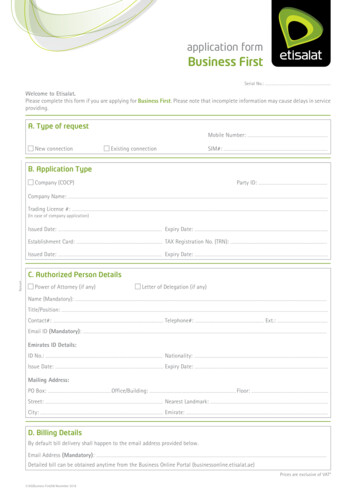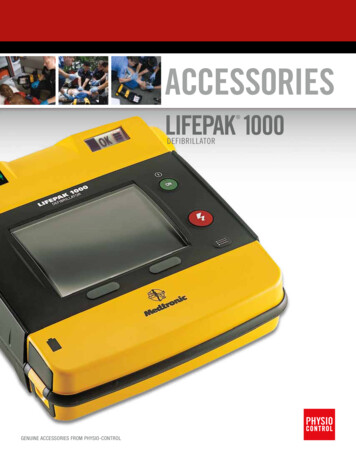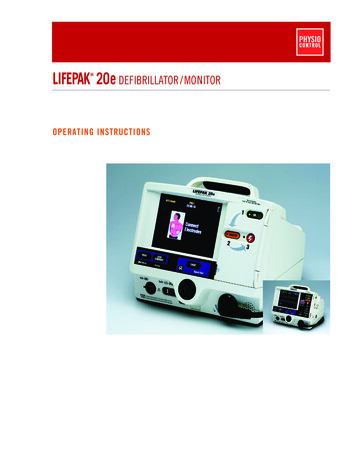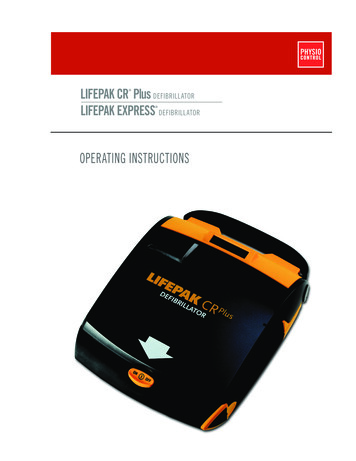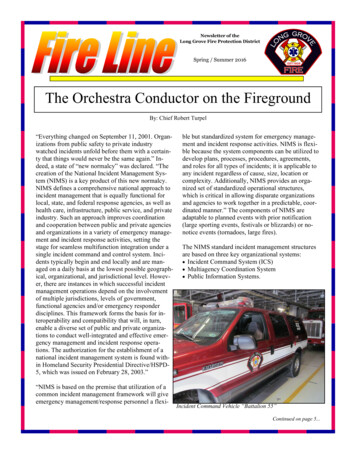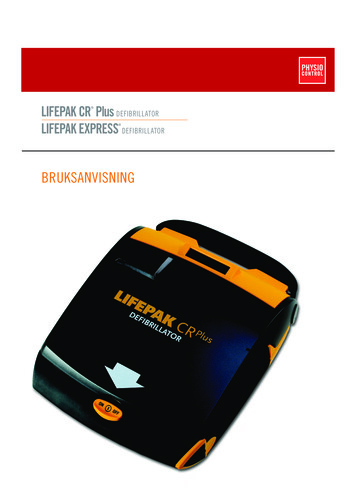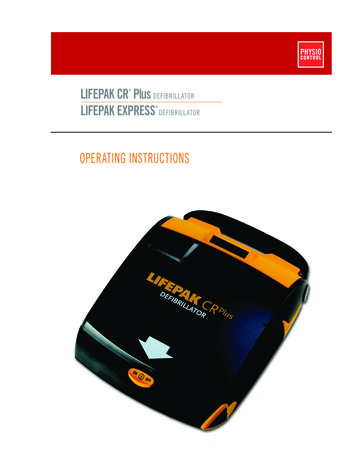
Transcription
LIFEPAK 500 Automated External DefibrillatorOperating Instructions
OPERATING INSTRUCTIONSLIFEPAK 500Automated External Defibrillator
IMPORTANTThis instrument is to be used by authorized personnel only.Responsibility for InformationIt is the responsibility of our customers to ensure that the appropriate person(s) within their organizationhave access to this information, including general safety information provided in Section 1.Revision HistoryThese operating instructions describe LIFEPAK 500 devices with the monophasic defibrillationwaveform (software version 5.7 or later) or the biphasic defibrillation waveform (software version 4.2 orlater). Older devices may not have all the features described in this manual.Medtronic Physio-Control11811 Willows Road NortheastPost Office Box 97006Redmond, WA 98073-9706 USATelephone: 425.867.4000Toll Free (USA only): 800.442.1142Fax: 425.867.4121Internet: www.physiocontrol.comwww.medtronic.comMedtronic Europe S.A.Medtronic Physio-ControlRte. du Molliau 31Case postale 841131 TolochenazSwitzerlandTelephone: 41.21.802.7000Fax: 41.21.802.7900PHYSIO-CONTROL, LIFEPAK, and FAST-PATCH are registered trademarks of Medtronic Physio-Control Corp. CODE SUMMARY,QUIK-COMBO, QUIK-VIEW, Data Transfer 500, REDI-PAK, Shock Advisory System, CODE-STAT, LIFENET MD, and PARTSLINE aretrademarks of Medtronic Physio-Control Corp. Medtronic is a registered trademark of Medtronic, Inc. Hayes and ACCURA are trademarks ofHayes microcomputer Products, Inc. U.S. Robotics and Sportster are registered trademarks of U.S. Robotics. Microsoft and Windows areregistered trademarks of Microsoft Corporation. SupraExpress is a trademark of Supra Corporation. EPSON and EPSON ESC/P areregistered trademarks of Seiko Epson Corporation. Specifications are subject to change without notice. 1996–2003 Medtronic Physio-Control Corp. All rights reserved.PN 3005338-022iiLIFEPAK 500 Automated External Defibrillator Operating Instructions
TABLE OF CONTENTSPrefaceAbout Defibrillation . xOperator Considerations . xIndications for Use . xFeatures of the LIFEPAK 500 Automated External Defibrillator .xiText Conventions. xiiDeclaration of Conformity . xiii1Safety InformationTerms . 1-2General Warnings and Cautions . 1-2Symbols . 1-32Getting ReadyUnpacking and Initial Inspection. 2-2Controls, Indicators, and Connectors . 2-2About Batteries . 2-5Setting the Clock . 2-6Defining Setup Options. 2-7Factory Default Settings . 2-11Changing Setup Options . 2-12Transferring Setup to Another LIFEPAK 500 AED . 2-15Connecting Electrodes to the AED . 2-16LIFEPAK 500 Automated External Defibrillator Operating Instructions 1996–2003 Medtronic Physio-Control Corp.iii
3Using the LIFEPAK 500 AEDWarnings and Cautions . 3-2Preparing the AED for Operation. 3-2AED Operation . 3-3AED Prompts. 3-4Patient Care Transfer to a Different Device. 3-10Troubleshooting During Patient Care . 3-104Data ManagementOverview of Data Storage and Retrieval . 4-2Sending Data to a Computer by Modem . 4-4Sending Data to a Computer by Direct Connection. 4-7Sending Data to a Printer . 4-85MaintenanceMaintenance and Testing Scheduling . 5-2Inspection . 5-2Cleaning . 5-3Testing. 5-4Battery Maintenance. 5-7Electrode Storage. 5-12Service and Repair . 5-12Warranty . 5-12Supplies, Accessories, and Training Tools. 5-13Specifications . 5-14Clinical Summary: Defibrillation of Ventricular Fibrillation and Ventricular Tachycardia. 5-186TroubleshootingTroubleshooting During Patient Care . 6-2Appendix A: Shock Advisory SystemAppendix B: LIFEPAK 500 Operator’s ChecklistAppendix C: FAST-PATCH Defibrillation Cable Instructions for UseAppendix D: QUIK-COMBO Defibrillation Cable Instructions for UseIndexivLIFEPAK 500 Automated External Defibrillator Operating Instructions
LIST OF FIGURESFigure 2-1Figure 2-2Figure 2-3Figure 2-4Figure 2-5LIFEPAK 500 AED controls, indicators, and connectors . 2-2Accessories for the LIFEPAK 500 AED. 2-4Battery installation . 2-5Setup transfer connections. 2-15Connecting the QUIK-COMBO electrodes . 2-16Figure 3-1Figure 3-2Anterior-lateral position . 3-3Anterior-posterior placement . 3-4Figure 4-1Figure 4-2Figure 4-3Figure 4-4Figure 4-5Figure 4-6Figure 4-7Figure 4-8Figure 4-9Figure 4-10Figure 4-11Data stored by the LIFEPAK 500 AED. 4-2Comparison of data stored for the Current Patient and Previous Patient . 4-2Data stored when the AED stores a new patient record . 4-3Equipment connections for data transfer by modem. 4-5Equipment connections for data transfer by direct connection to a computer. 4-7Connecting the AED to a printer. 4-8Example of Event Log Report and Event Log Summary. 4-10Example of CODE SUMMARY Report. 4-11Example of CODE SUMMARY Report (cont.). 4-12Example of CODE SUMMARY Report (cont.). 4-13Example of Test Log Report. 4-14Figure 5-1Figure 5-2Test load connection . 5-6LiSO2 battery capacity over 5 years while installed in a LIFEPAK 500 AEDat 20 C (68 F) . 5-8SLA battery capacity while installed in a LIFEPAK 500 AED for 3 monthswithout recharging at 20 C (68 F). 5-10Figure 5-3LIFEPAK 500 Automated External Defibrillator Operating Instructions 1996–2003 Medtronic Physio-Control Corp.v
LIST OF TABLESTable 2-1Table 2-2Table 2-3Table 2-4Table 2-5Controls, Indicators, and Connectors . 2-2Accessories for the LIFEPAK 500 AED . 2-4MODEM PHONE NUMBER Dial String Characters . 2-7MODEM SELECTION Numbers. 2-7Setup Options and Factory Default Settings. 2-11Table 4-1Table 4-2Table 4-3Table 4-4LIFEPAK 500 AED Data and Retrieval. 4-4Required Resources for Sending Data to a Computer by Modem. 4-4Required Resources for Sending Data to a Computer by Direct Connection . 4-7Required Resources for Printing Data . 4-8Table 5-1Table 5-2Table 5-3Table 5-4Table 5-5LIFEPAK 500 AED Inspection . 5-2Recommended Cleaning Methods . 5-3Supplies, Accessories, and Training Tools. 5-13LIFEPAK 500 AED Specifications1 . 5-14LIFEPAK 500 AED Battery Charger Specifications . 5-18Table 6-1Table 6-2Table 6-3Table 6-4Table 6-5Table 6-6Table 6-7Troubleshooting During Patient Care . 6-2Troubleshooting During Modem Data Transfer . 6-3Troubleshooting During Printing . 6-4Troubleshooting During Setup Transfer. 6-4LIFEPAK 500 AED Screen Messages . 6-5LIFEPAK 500 AED Voice Prompts . 6-6LIFEPAK 500 AED Event Types. 6-7Table A-1Table A-2LIFEPAK 500 AED SAS Performance Table for Adult ECGs.A-1LIFEPAK 500 AED SAS Performance Table for Pediatric ECGs .A-2LIFEPAK 500 Automated External Defibrillator Operating Instructions 1996–2003 Medtronic Physio-Control Corp.vii
PrefacePREFACEAbout DefibrillationOperator ConsiderationsIndications for UseFeatures of the LIFEPAK 500 AutomatedExternal DefibrillatorText ConventionsDeclaration of ConformityLIFEPAK 500 Automated External Defibrillator Operating Instructions 1996–2003 Medtronic Physio-Control Corp.page xxxxixiixiiiix
PrefaceABOUT DEFIBRILLATIONDefibrillation is a recognized means of terminating certain potentially fatal arrhythmias. A direct currentdefibrillator applies a brief, high-energy pulse of electricity to the heart muscle. The LIFEPAK 500automated external defibrillator (AED) delivers this energy through disposable defibrillation electrodesapplied to the patient's chest.Defibrillation is only one aspect of the medical care required to resuscitate a patient with a shockableECG rhythm. Depending on the situation, other supportive measures may include: Cardiopulmonary resuscitation (CPR) Administration of supplemental oxygen Drug therapyIt is recognized that successful resuscitation is related to the length of time between the onset of a heartrhythm that does not circulate blood (ventricular fibrillation, pulseless ventricular tachycardia) anddefibrillation. The American Heart Association has identified the following as critical links in the chain ofsurvival from cardiac arrest: Early accessEarly CPR by first responders or bystandersEarly defibrillationEarly advanced life supportThe physiological state of the patient may affect the likelihood of successful defibrillation. Thus, failureto resuscitate a patient is not a reliable indicator of defibrillator performance. Often, patients will exhibita muscular response (such as jumping or twitching) during energy transfer. The absence of such aresponse is not a reliable indicator of actual energy delivery or device performance.OPERATOR CONSIDERATIONSThe LIFEPAK 500 AED is a semi-automatic defibrillator that uses a patented Shock Advisory System .This software algorithm analyzes the patient's electrocardiographic (ECG) rhythm and indicateswhether or not it detects a shockable rhythm. The LIFEPAK 500 AED requires operator interaction inorder to defibrillate the patient.The LIFEPAK 500 AED is intended for use by personnel who are authorized by a physician/medicaldirector and have, at a minimum, the following skills and training: CPR training AED training equivalent to that recommended by the American Heart Association Training in the use of the LIFEPAK 500 AEDThe LIFEPAK 500 AED is intended for use in the hospital and out-of-hospital environments. It has beentested to RTCA/DO-160C, “Environmental Conditions and Test Procedures for Airborne Equipment”(refer to Specifications, page 5-16).INDICATIONS FOR USEThe LIFEPAK 500 AED is to be used only on patients in cardiopulmonary arrest. The patient must beunconscious, not breathing normally, and showing no signs of circulation (for example, no pulse, and/orno coughing, no movement) before the device is used to analyze the patient's ECG rhythm. WithInfant/Child Reduced Energy Defibrillation Electrodes, the specially configured biphasic LIFEPAK 500AED may be used on children up to 8 years old or 25 kg (55 lb).xLIFEPAK 500 Automated External Defibrillator Operating Instructions
PrefacePrefaceFEATURES OF THE LIFEPAK 500 AUTOMATED EXTERNAL DEFIBRILLATORThe optional and configurable features of the LIFEPAK 500 AED are designed to meet a variety ofprotocol needs. Authorized operators of this AED should always use the AED in accordance with localprotocols.Defibrillation WaveformThe LIFEPAK 500 AED is available with one of two defibrillation waveforms: monophasic or biphasic.For a description of each defibrillation waveform, refer to page 5-14 and page 5-17. The LIFEPAK 500AED control and display functions are the same for either defibrillation waveform.Defibrillation ElectrodesThe LIFEPAK 500 AED uses disposable QUIK-COMBO pacing/defibrillation/ECG electrodes, with orwithout the REDI-PAK preconnect system, and FAST-PATCH disposable defibrillation/ECGelectrodes. The use of these electrodes allows rapid transfer of care to other devices that also use thesame type of Medtronic Physio-Control electrodes.Infant/Child Reduced Energy Defibrillation Electrodes can be used only with a biphasic LIFEPAK 500AED that has been modified specifically to accept these electrodes. (Refer to Item 4, Cable Connectoron page 2-3.) Infant/Child Reduced Energy Defibrillation Electrodes are not transferable to manualdefibrillator/monitors.Automated OperationThe operator controls AED operation with two or three top-panel buttons (ON/OFF, ANALYZE [optional],and SHOCK). For LIFEPAK 500 AEDs that do not have an ANALYZE button, the AED operates in AUTOANALYZE 2 mode (see page 2-9).The AED guides the operator through operating procedures with a combination of: Voice promptsTonesFlashing LEDsScreen messagesThe screen messages appear on a two-line liquid crystal display (LCD). Other LCD informationincludes: Real-time clockCumulative shock counterStatus and service messagesCPR countdown timerContinuous MonitoringThe LIFEPAK 500 AED operates in two modes: ECG analysis and Continuous Patient SurveillanceSystem (CPSS). During analysis, the AED indicates if it detects a shockable or nonshockable rhythm.The CPSS, which is active when the AED is not performing an analysis, automatically monitors for apotentially shockable rhythm.Motion DetectionThe LIFEPAK 500 AED includes a patented system that detects motion. When motion that could distortthe ECG rhythm occurs, the ECG data is automatically excluded from analysis by the motion detectionsystem.LIFEPAK 500 Automated External Defibrillator Operating Instructions 1996–2003 Medtronic Physio-Control Corp.xi
PrefaceData ManagementThe LIFEPAK 500 AED digitally records patient data, including ECG rhythm and delivered shocks. Adigital audio recording of scene activity is available as an option. Recorded data may be transferred bydirect connection to a printer or computer or by a modem to a remote computer. Three optional,Microsoft Windows -compatible data management software programs are available. The DataTransfer 500 program transfers, stores, and prints AED reports. The QUIK-VIEW 500 data reviewprogram includes all of the Data Transfer 500 functions and the capability to review ECG and audiodata on a computer. The CODE-STAT Suite data management system provides comprehensive andvaried data storage, review, and reporting capabilities for quality assessment and system performanceanalysis.Battery OptionsA rechargeable sealed lead-acid battery or one of two nonrechargeable lithium batteries (sulfur dioxideor manganese dioxide) provide power to the AED. The rechargeable battery requires periodicrecharging by an external battery charger.Automatic Self-TestThe AED performs an automatic self-test every 24 hours and every time you turn on the AED. Thisfeature tests the most important circuitry in the device to give the user a high degree of confidence thatthe AED is ready for use.Readiness DisplayThe LIFEPAK 500 AED with the biphasic waveform includes a Readiness Display on the device’shandle that can be seen at all times. OK displays if the automatic self-test is completed successfully. Ifthe self-test detects that service is required or if the device detects that the battery needs immediatereplacement, the OK indicator disappears and a service and/or battery indicator appear(s).Customized SetupAED operation may be customized by accessing a setup mode. Definable operating features includethe modem phone number, the time interval allowed for CPR, and other features. Once you havecustomized the setup, the TRANSFER SETUP feature enables you to quickly transfer the setup to otherLIFEPAK 500 AEDs.Optional AccessoriesAn optional carrying case helps to protect the AED and provides a pouch to store electrodes. Use thePhysio-Control LIFEPAK AED TRAINER to train operators to use the LIFEPAK 500 AED.TEXT CONVENTIONSThroughout this manual, special text characters are used to indicate labels, LCD messages, and voiceprompts:Operating control labels:CAPITAL LETTERS such as ON/OFF and SHOCK.LCD messages:CAPITAL LETTERS such as CONNECT ELECTRODES.Voice prompts:CAPITAL ITALICIZED LETTERS such as PUSH ANALYZE.xiiLIFEPAK 500 Automated External Defibrillator Operating Instructions
PrefacePrefaceDECLARATION OF CONFORMITYaccording to EN 45014Manufacturer’s Name:Medtronic Physio-Control Corp.Manufacturer’s Address:11811 Willows Road NEP.O. Box 97006Redmond, WA 98073-9706USAdeclares that the CE-marked productProduct Name:LIFEPAK 500 automated external defibrillatorModel Number:3005400 (monophasic)3011790 (biphasic)complies with 93/42/EEC (Medical Device Directive) Class Ilb, conformity assessed per Annex II.Safety:EN60601-1:1996/ IEC 60601-1:1995internally powered, Type BF, Continuous operation.IEC 60601-2-4:1983EMC:EN60601-1-2:1993/IEC 60601-1-2:EN 55011:1991- Class B, Group 1EN61000-4-2 1st edition - 8kV CD, 15 kV ADIEC61000-4-3 1st edition - 3 V/mEN61000-4-4 1st edition - Not ApplicableIEC61000-4-5/EN61000-4-5 1st edition - Not ApplicableSupplementary Information:Included are the following accessories and interconnecting cables:QUIK-COMBO electrode set, PN 806086, 3008997, 3008826 or3010188-001FAST-PATCH electrodes, PN 3006292 or 3010188-002FAST-PATCH defibrillation cable, PN 3010493Sealed lead-acid battery, PN 3005379Lithium battery, PN 3200390, 3005380Battery Charger (non-medical), PN 3006535Data transfer cable (non-medical), PN 3005381Infant/Child Reduced Energy Defibrillation Electrodes(specially configured biphasic AEDs only), PN 3202380This product also complies with:UL 2601-1:1994,CSA C22.2 No. 601.1 and CSA C22.2 No. 601.2.4,AAMI ES1, AAMI DF39Redmond, January 28, 2003Michael D. WillinghamVice President of Quality and Regulatory AffairsEuropean Contact: Your local Medtronic Physio-Control Sales and Service Office orMedtronic B.V., Earl Bakkenstraat 10, 6422 PJ Heerlen,The NetherlandsLIFEPAK 500 Automated External Defibrillator Operating Instructions 1996–2003 Medtronic Physio-Control Corp.xiii
PrefaceDECLARATION OF CONFORMITYAult, Incorporated7300 Boone Avenue NorthMinneapolis, MN 55428-1028U.S.A.We hereby declare under our sole responsibility that the product model(s) BCWA-042000-100A andBCWA-042000-100N (PHYSIO-CONTROL LIFEPAK 500 Battery Charger), a power supply intended foruse as a battery charger in household and other similar applications, to which this declaration relates,meets the requirements of the following New Approach Directives: Electro-Magnetic Compatibility (EMC) Directive 89/336/EEC as demonstrated by compliance toEN50082-1:1992 Generic Immunity, IEC 801-2:1991 and IEC 1000-4-2:1995 Electrostatic DischargeImmunity, ENV50140:1993 and IEC 1000-4-3:1995 Radiated Electromagnetic Field Immunity, IEC 8014:1988 Electrical Fast Transient/Burst, and EN 55022:1994 Class B limits for Radiated and ConductedEmissions. Low Voltage Directive (LVD) 73/23/EEC as demonstrated by compliance with EN 60065/09.93 Safetyrequirements for mains operated electronic and related apparatus for household and similar generaluse.This declaration is backed by third party assessments to the noted European Norm standards. AultIncorporated is an ISO 9001 registered firm, Certificate Number FM11881.Tim CassidyProduct Safety Engineer28 October 1996xivLIFEPAK 500 Automated External Defibrillator Operating Instructions
11-01-0SAFETY INFORMATION1 Safety InformationThis section provides important information to help you operate the LIFEPAK 500 automated externaldefibrillator (AED). Familiarize yourself with all of these terms, warnings, and symbols.TermsGeneral Warnings and CautionsSymbolsLIFEPAK 500 Automated External Defibrillator Operating Instructions 1996–2003 Medtronic Physio-Control Corp.page 1-21-21-31-1
Safety InformationTERMSThe following terms are used either in this manual or on the LIFEPAK 500 AED:Danger:Immediate hazards that will result in serious personal injury or death.Warning:Hazards or unsafe practices that could result in serious personal injury or death.Caution:Hazards or unsafe practices that could result in minor personal injury, product damage, orproperty damage.GENERAL WARNINGS AND CAUTIONSThe following section provides general warning and caution statements. Other specific warnings andcautions are provided as needed in other sections of this manual.WARNINGS!Shock hazard.The defibrillator delivers up to 360 joules of electrical energy. Unless properly used as described inthese Operating Instructions, this electrical energy may cause serious injury or death. Do not attempt tooperate this device unless thoroughly familiar with these Operating Instructions, and the function of allcontrols, indicators, connections, and accessories.Shock hazard.Do not disassemble the defibrillator. It contains no operator serviceable components and dangeroushigh voltages may be present. Contact authorized service personnel for repair.Shock or fire hazard.Do not immerse any portion of this device in water or other fluids. Avoid spilling any fluids on device oraccessories. Do not clean with ketones or other flammable agents. Do not autoclave or sterilize thisdevice or accessories unless otherwise specified.Possible fire or explosion.Do not use this device in the presence of flammable gases or anesthetics. Use care when operatingthis device close to oxygen sources (such as bag-valve-mask devices or ventilator tubing). Turn off gassource or move source away from patient during defibrillation.Possible electrical interference with device performance.Equipment operating in close proximity may emit strong electromagnetic or radio frequencyinterference (RFI) which could affect the performance of this device. RFI may result in distorted ECGand failure to detect a shockable rhythm. Avoid operating device near cauterizers, diathermyequipment, or cellular phones. Maintain equipment separation of at least four feet and do not rapidlykey EMS radios on and off. Contact Technical Support if assistance is required.Possible electrical interference.This defibrillator may cause electromagnetic interference (EMI) especially during charge and energytransfers. EMI may affect the performance of equipment operating in close proximity. Verify the effectsof defibrillator discharge on other equipment prior to using defibrillator in an emergency situation, ifpossible.Possible device shutdown.Always have access to a spare, fully-charged, properly maintained battery. Replace the battery whenthe device displays a low battery warning.1-2LIFEPAK 500 Automated External Defibrillator Operating Instructions
Safety InformationWARNINGS!Possible improper device performance.Using other manufacturers’ cables, electrodes, or batteries may cause the device to perform improperlyand invalidates the safety agency certification. Use only the accessories specified in these OperatingInstructions.Safety risk and possible equipment damage.Monitors, defibrillators, and their accessories (including electrodes and cables) contain ferromagneticmaterials. As with all ferromagnetic equipment, these products must not be used in the presence of thehigh magnetic field created by a Magnetic Resonance Imaging (MRI) device. The high magnetic fieldcreated by an MRI device will attract the equipment with a force sufficient to cause death or seriouspersonal injury to persons between the equipment and the MRI device. This magnetic attraction mayalso damage the equipment. Skin burns will also occur due to heating of electrically conductivematerials, such as patient leads and pulse oximeter sensors. Consult the MRI manufacturer for moreinformation.1 Safety InformationShock hazard.Do not insert a hand, foot, or any object other than a battery into the battery well of this device.CAUTION!Possible equipment damage.This device may be damaged by mechanical or physical abuse such as immersion in water or
The LIFEPAK 500 AED is intended for use in the hospital and out-of-hospital environments. It has been tested to RTCA/DO-160C, "Environmental Conditions and Test Procedures for Airborne Equipment" (refer to Specifications, page 5-16). INDICATIONS FOR USE The LIFEPAK 500 AED is to be used only on patients in cardiopulmonary arrest.
